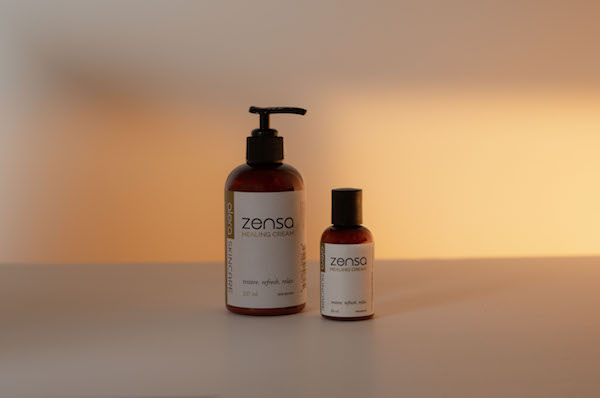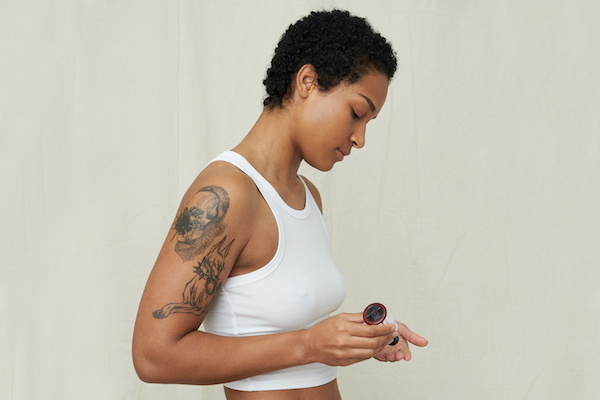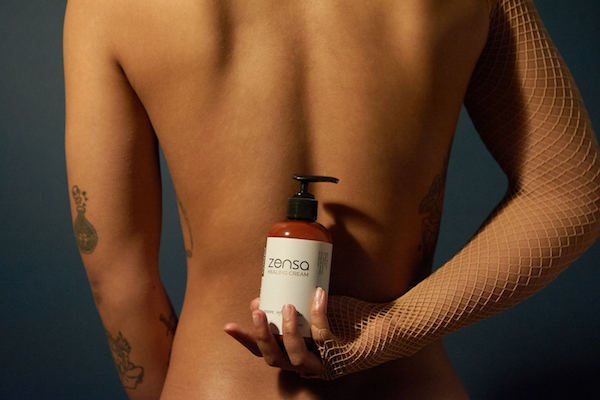What is Hyaluronic Acid?: Benefits, How To Use It, and More
What is Hyaluronic Acid?: Benefits, How To Use It, and More
You already know that hydration is essential for healthy skin. Yet finding the best ingredients for your skin type and needs can feel a bit tricky – especially if you have any skin conditions or are prone to breakouts. Fortunately, hyaluronic acid offers a highly effective option that is perfect for everyday use and during the tattoo or permanent makeup healing processes.
Hyaluronic acid is a large molecule naturally found in your skin and body’s connective tissues. It keeps your skin, eyes and hair hydrated while also cushioning your joints. 50% of your body’s hyaluronic acid supply is stored in the skin and can hold around 1,000 times its weight in water. It absorbs and retains water molecules to bind with collagen – resulting in fresher, more supple skin.
As a skincare ingredient, hyaluronic acid is a humectant (a substance that helps retain water) and often is used in serums, lotions, creams, and toners to achieve a more hydrated complexion. Hyaluronic acid supplements and fillers are other popular forms of the substance used to revitalize skin.
Read on to learn more about hyaluronic acid’s benefits, how to use it, and answers to the most common questions below.
Hyaluronic Acid Skin Benefits:

Topical hyaluronic acid products provide a simple, over-the-counter option with many affordable selections available at your local drug store. These formulas have proven to be highly effective, fast-absorbing and non-irritating with few to no side effects. However, these indigestible and injectable options must be prescribed by a doctor.
A 2014 study found that topically-applied hyaluronic acid – as a serum, lotion or cream – improved skin hydration by up to 96% and skin elasticity by up to 55% in participants over 8 weeks. Better skin elasticity correlates with a more resilient moisture barrier and quicker, less painful skin repair processes during the tattoo and permanent makeup healing stages, too.

Prevents Dry, Itchy Skin
Hyaluronic acid’s hydration-locking properties make it a great option for individuals with dry skin and are particularly beneficial throughout the colder months. During the winter, the dry weather conditions and indoor heaters strip your skin of its natural moisture. Skin stripped of its moisture barrier can leave you with dry, flaky, itchy or inflamed skin. Dry skin is thinner than hydrated skin and is more prone to cracking and often leads to uncomfortable side effects, such as burning, bleeding, redness, eczema flare-ups and increased symptoms from other chronic skin conditions. This nutrient-depleted skin also makes you more vulnerable to contracting a bacterial or fungal skin infection.

Regularly applying or supplementing hyaluronic acid helps build a more protective barrier under the skin and makes it less likely to thin. Plumper, thicker skin creates a shield that prevents cracking and irritation that can cause uncomfortable symptoms like burning, itching, and flare-ups from chronic skin conditions like eczema or rosacea.
Slows Signs of Aging
A youthful glow goes hand-in-hand with well-hydrated and collagen-rich skin. Without retaining enough moisture, your skin elasticity and your collagen levels drop. Drier, less elastic skin invites the formation of wrinkles, fine lines, and sun damage. Using hyaluronic acid nourishes the skin’s moisture barrier to replenish its elasticity. Rehydrating the skin improves its overall firmness and helps reduce the appearance of fine lines and wrinkles over time. In the same 2014 study mentioned above, the participants saw up to 40% decreased depth in wrinkles when applying hyaluronic acid daily compared to those who did not.
For enhanced results, hyaluronic acid supplements and fillers provide anti-aging benefits for the skin. A 2017 study found that participants taking a hyaluronic supplement daily had significantly improved skin hydration (by around 24%) and elasticity (by around 13%) with an average 26% reduction in wrinkle depth over a 40-day trial period.
Hyaluronic acid fillers use a substance that already exists in the body and can be considered a more natural alternative to Botox. These injectables are most commonly used to revive youthful plumpness in the lips and cheeks – areas of the face that naturally decrease in volume with age. Hyaluronic acid fillers work by attracting water to the area that creates volume in the skin to fill any fine lines or wrinkles, resulting in a smooth complexion. Unlike Botox, hyaluronic acid fillers do not freeze the muscle and are for restorative – not for preventative – use.

Improves and Evens Skin Texture
Like collagen production, your hyaluronic acid reserves decrease with age, which leaves you with drier, thinner skin. These depleted skin cells have a slower cell turnover rate – making you more likely to experience rough skin texture, flaky patches, clogged pores, redness, acne and hyperpigmentation.
A resilient skin lipid barrier is crucial to achieving a smooth and (nearly) uniformly-toned complexion. In the same 2017 study, researchers found that participants experienced an almost nearly 17% decrease in skin roughness after 40 days. The increased moisture and collagen improve your skin’s resilience, which can help decrease (or eliminate) redness, acne, flaky or cracked skin, scarring, sun spots and other tone or texture concerns.
While beneficial for all skin types, hyaluronic acid is known for its non-irritating properties – making it a great option for sensitive or acne-prone skin. With regular use, hyaluronic acid can have a positive long-term effect to improve and strengthen the skin barrier to lessen its likelihood of irritation and increase cellular turnover to prevent clogged pores that precede acne formation.
Promotes Wound Healing
Hyaluronic acid speeds up the healing process by decreasing inflammation and directing new blood vessels to form on the wounded area. The ingredient stimulates collagen production and increases cell turnover to quickly replenish a fresh layer of healthy skin over the injured region. Hyaluronic acid also helps alleviate wound pain more readily, and it contains anti-bacterial properties to prevent infections during the healing process.

This ingredient and its wound-healing abilities aid in treating burns, chronic skin conditions, cosmetic treatment after-care (including microneedling, laser hair removal and waxing) and during the tattoo healing stages. Using nourishing lotions and creams, like Zensa Healing Cream, before and after these treatments can help you maintain a healthy skin barrier going into the procedure and provide a smoother recovery.
What percentage of hyaluronic acid is best?
The most direct answer is 2% for optimal benefits. However, it can get a bit confusing once you start seeing brands claiming to use up to 99% or 100% hyaluronic acid in their products. Let us explain how the sodium hyaluronic vs. hyaluronic acid distinction comes into play. Sodium hyaluronate is the salt form of hyaluronic acid and has a smaller molecular size that better penetrates the skin. Many brands use these terms interchangeably to refer to hyaluronic acid on the products’ ingredient lists. However, sodium hyaluronate is never packaged in its pure form. It always is mixed into a solution with 1-2% sodium hyaluronate (the rest is water). Products with more than 4% sodium hyaluronate will have the opposite effect and dry out your skin.
How To Use & Layer Hyaluronic Acid
For topical use, Hyaluronic acid serums, lotions or creams should be applied twice a day – once in the morning and the evening – onto damp skin. While these serums provide hydrating benefits, humectants need to be paired with an emollient product to lock in the moisture into your skin. Ceramides, aloe vera, linolenic acid and shea butter are some of the most popular emollients. When used as a moisturizer on top of hyaluronic acid, this is a winning hydration combination for soft, smooth skin.
Pair your serum, toner or cream with skincare products containing vitamin C and B5 to optimize hyaluronic acid’s powerful benefits.

Vitamin C provides protection against sun damage, brightens the skin, decreases hyperpigmentation, exfoliates, and stimulates an anti-inflammatory response to reduce redness and acne while boosting collagen production. Alone, vitamin C can be drying, so layering it with hyaluronic acid provides a perfect moisture balance that doesn’t overwork the skin.
Vitamin B5 soothes redness, irritation, and acne, helps minimize scarring and calms flare-ups from chronic skin conditions, including eczema and rosacea. Its anti-inflammatory properties pair well with hyaluronic acid to hydrate and improve skin elasticity.
When seeking out hyaluronic acid fillers (or supplements), get a trusted doctor’s opinion before integrating this ingredient into your routine.
Hyaluronic Acid FAQs:
Does hyaluronic acid have any side effects?
There are no proven side effects for hyaluronic acid when applied topically or taken orally. While hyaluronic acid fillers rarely cause any specific side effects, bruising, redness and swelling are common at any injection site.
Which skin types should use hyaluronic acid?
Hyaluronic acid is suitable for all skin types and is especially beneficial for individuals with dry skin. It is gentle enough to use on sensitive or acne-prone skin and the anti-inflammatory benefits promote a smoother, more resilient skin texture.

Can you use hyaluronic acid and retinol together?
Yes – hyaluronic acid and retinol are a powerful combination to boost collagen, hydrate the skin and prevent wrinkles, fine lines and any retinol-related irritation. Make sure to apply your hyaluronic acid before your retinol product. However, if you’ve never used this combination, patch test these ingredients together on your skin. Hyaluronic acid boosts the absorption of the products you layer over it. So, especially if you’re new to using retinol, you want to ensure that this duo does not make the retinol irritate your skin.
Can you mix hyaluronic acid with niacinamide or glycolic acid?
Niacinamide and glycolic acid both combine well with hyaluronic acid.
If you have very dry, dehydrated or oil and acne-prone skin, consider using niacinamide and hyaluronic acid together. This combination provides a boost in collagen production, skin elasticity, and a double hydration effect. Make sure to apply your hyaluronic acid before your niacinamide.
Unlike hyaluronic acid, glycolic acid is an actual acid that exfoliates the skin to brush off dead skin cells. Hyaluronic acid can also prevent potential skin irritation from glycolic acid. Apply your glycolic acid before the hyaluronic acid to exfoliate your skin before re-hydrating it. If you have particularly sensitive skin, make sure to apply the glycolic acid on dry skin then dampen your face to prime it for the hyaluronic acid. Never use both vitamin C and glycolic acid together with hyaluronic acid.
When should you not use hyaluronic acid?
While gentle, hyaluronic acid should be avoided for around 2 weeks before and any time after a microblading or nanoblading (nano brows) appointment. Its wrinkle-preventing qualities can alter your results. However, hyaluronic acid is a great option to use before and after microneedling or a tattoo to keep the skin nourished and hydrated.
